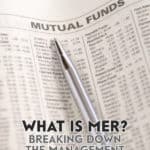What Is MER? Breaking Down the Management Expense Ratio

If you’ve owned mutual funds in the past, you’ve probably heard of the term, MER. But what does it mean, and can it have an impact on your long-term investment success? The answer to the last part of that question is a resounding yes. Every serious investor should have a basic understanding of how MERs work, and of the impact they have on an investment portfolio.
What Is MER?
In the investing world, MER stands for Management Expense Ratio. It’s an annual fee charged to mutual fund and ETF investors to cover the fund’s operating costs. The MER is expressed as a percentage of the overall value of the fund. For example, if you have 30,000 invested in a mutual fund with a 2% MER, your share of the cost will be $600.
Breaking Down the MER
While the main component of an MER is usually the management fee paid to the fund’s managers, it comprises several other expenses. Here is a list of expenditures that may or may not be included in your fund’s MER:
- Management fees to fund manager (to cover salaries, commissions)
- Legal fees
- Sales taxes (i.e., HST)
- Office expenses and other administration costs
Real-Life MER Examples
To illustrate how MERs are charged on different types of investment funds, I’ve created the following list of mutual funds and ETFs.
| Fund Name | Fund Code | Fund Type | MER |
|---|---|---|---|
| TD Canadian Equity Fund | TDB161 | CAD Equity Mutual Fund | 2.16% |
| Fidelity US Dividend Fund | 966 | US Equity Mutual Fund | 2.30% |
| Horizons S&P/TSX 60 ETF | HXT | CAD Equity ETF | 0.04% |
| iShares Core S&P/TSX | XIC | CAD Equity ETF | 0.06% |
| Vanguard Balanced ETF | VBAL | Asset Allocation ETF | 0.25% |
What Is a Good MER?
The short answer is, the lower the MER, the better. But that doesn’t tell the whole story. In a world where MERs on actively traded mutual funds can be in the neighbourhood of 2%, a .50% MER on a robo-advisor portfolio or index mutual fund seems like a steal. But you can easily find broad market ETFs with MERs under .10%.
It may seem like a no-brainer to always choose the lowest MER fund or ETF, but you need to make sure you’re comparing apples to apples. For example, the extra .40% MER charged by a robo-advisor ETF might be worth the cost if you value the convenience of automated contributions and rebalancing.
The Case Against High MER Mutual Funds
Actively traded mutual funds have some of the highest MERs in the industry because the fund manager’s goal is to not only match market returns but to outperform. This approach requires significantly more oversight, from the shifting of fund positions to the use of complex investment strategies based on the anticipated market conditions.
The problem is that the majority of the time, fund managers are unable to beat the average returns of the market, and the high MERs act as an anchor, weighing down overall returns. In the US, more than 85% of actively managed mutual funds underperformed their respective benchmark over a 15-year period. In Canada, the story would no doubt be a similar one.
A Passive Solution
For the past several years, investors have flocked to passively managed, low MER funds, like broad market index funds and exchange-traded funds, or ETFs. A passive management strategy requires less oversight because the goal is to simply match the returns of an underlying stock index. This reduces the costs of managing funds, which are reflected in the ultra-low MERs.
Where Can I Buy Low MER Funds?
Unfortunately, the big banks continue to stick to high-cost active mutual funds, sold by advisors in branches and online. I should point out that TD Bank offers their highly-rated TD e-Series index funds, which feature low MERs and track various underlying stock indexes. You can’t purchase them at a branch, however. You have to buy them through a TD Direct Investing account, or a competing online broker that sells them.
The best way to purchase low MER index funds or ETFs is through a robo-advisor, such as Wealthsimple, or a discount brokerage, like Questrade. The management fee on a Wealthsimple portfolio will be a bit higher than the lowest MER ETFs, because of the investment management component that you get with a robo-advisor, i.e. target portfolios, automatic rebalancing, etc.
If you’re looking for the lowest MER ETFs, Questrade is a great choice. Not only do they have hundreds of them available, but they also don’t charge a trading fee when you buy ETFs, further reducing your investment costs. For more information on Questrade and other online brokers, check out our guide to the Best Canadian Discount Brokerages.
Final Thoughts on the Management Expense Ratio (MER)
If you want to save money on MERs, you’ll need to follow a passive investment strategy by holding either low-cost index mutual funds or ETFs. But MERs aren’t the only expenditures to consider when building an investment portfolio.
For example, if you pay an investment advisor for portfolio management, you must account for the investment management fees they charge. If you’re a DIY investor making your own investment decisions, you need to factor in trading fees, charged when buying and selling many stocks and ETFs.
If you need some help understanding how MERs and other investment fees are impacting your returns, I recommend that you consult with a trusted investment professional.

